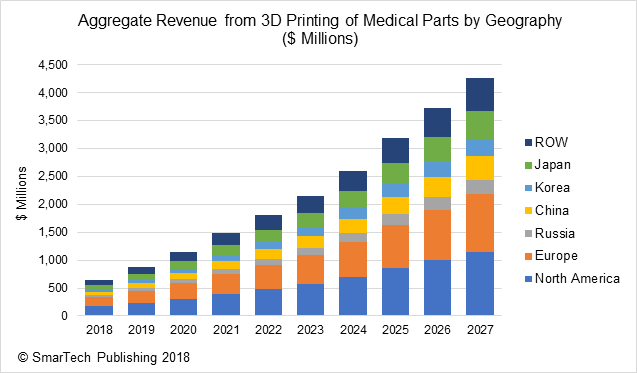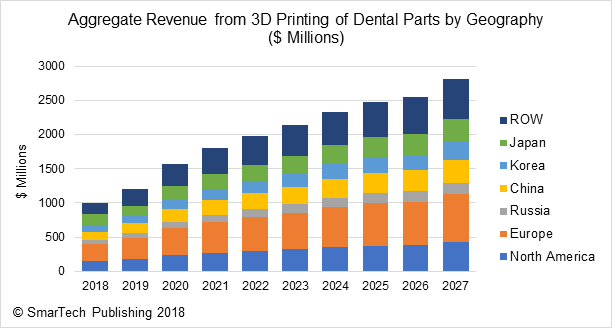Leading industry analysis firm, SmarTech, just published a report on emerging metal printing opportunities for 3DP service bureaus. The new report, Metal 3D Printing Services: Service Revenues, Printer Purchases, and Materials Consumption – 2018 To 2027, contains corporate profiles (showing how leading service bureaus are taking advantage of metal printing), and granular 10-year forecasts, with break outs by industry verticals, types of metal, type of printers/3DP processes, uses and types of metals printed.

This report is the first from a new group at SmarTech which is focusing on service bureau opportunities. The SmarTech team is currently at work building a comprehensive forecasting model for service bureau revenues, printer purchases, install base, and materials consumption. This work will be based on the many studies of industry verticals for 3D printing undertaken by SmarTech over the past six years.
Metals 3DP and Service Bureaus: A Dilemma
Lawrence Gasman, President of SmarTech and author of the study, says that metal printing by service bureaus alone will generate $6.7 billion in revenues by 2023. According to Gasman, metals printing will be especially important to service bureaus. “Metals printing is more complex and harder for end-users to take ‘in house’ than polymer printing,” says Gasman, “but SmarTech’s research indicates that metal printing may be less profitable than polymer printing for bureaus. This is the paradox. From the service bureau perspective, metals printing may be where the growth is, but at the same time bureaus focusing more on metals could find their profit margins eroded.”
The new SmarTech report discusses ways around this dilemma including specialization in certain market verticals or in certain metals. However, it concludes that sustainable competitive advantage in the metals service bureau will come from two strategic approaches. One of these involves “hub networks” that distribute the responsibility for printing metals jobs booked by the hub company to many service bureaus based on geography, capacity, and technical capabilities. “Using proprietary software, hub networks can create efficiencies that can offset lower margins on printing metal products,” says Gasman. The SmarTech report also notes that making the actual metal printing part of a higher value-added offering that includes design and technical guidance will also be an important strategic route to profitable success for metal service bureau.
Medical, Dental and Metal
In addition to the usual suspects (automotive, aerospace, oil and gas), SmarTech reports that metal printing by service bureaus are expected to generate considerable revenues from the medical and dental sectors. While, much medical 3DP is polymer-based, there are important exceptions. Metal implants are mostly Ti64, commercially pure titanium or cobalt chrome alloys such as MP1.

Titanium alloys are the go-to implant material for orthopedic implants providing lightweight, biological inertness, and the ability to function as a load bearing implant. But despite the criticality of these materials, printing of these (and other) metal implants with PBF simply cannot be done in primary care environments due to requirements for safe handling of reactive materials, post-processing and post heat treatment requirements, and testing. And even though there is a general trend towards bringing medical/dental care closer to the patient, the fact that printing metals is not an easy thing to do will make this trend a slowly acting one.

This provides some advantage to metals service bureaus. “What we are seeing,” says SmarTech’s Gasman, “is that while some of the larger medical device leaders have begun investing more heavily in the internal production of additively manufactured implants, OEMs remain significantly focused on outsourcing to service bureaus in order to focus down on core competencies and R&D. However, bureaus planning to exploit this particular opportunity will have to acquire a high degree of specialization and process expertise.”

Meanwhile, in the dental sector, the equivalent of service bureau (confusingly still called milling centers), the 3D printing of metals is focused on producing metallic elements for porcelain-fused-to-metal (PFM) dental restorations and the metal hardware for dental implants (including the screw and the abutment to which the visible tooth-like portion of the implant is affixed). By 2023, SmarTech believes that over half service bureau revenues associated with metal printing will come from printing dental or medical products. Conversely, print services are expected to drive a majority share of total opportunities associated with medical and dental 3D printing in general.
The new SmarTech report on metal service bureaus is available now for purchase at Smart Tech Publishing here. For more details on this report contact Rob Nolan at rob@smartechpublishing.com
3DPrint.com is an equity holder of Smartech Publishing.
Subscribe to Our Email Newsletter
Stay up-to-date on all the latest news from the 3D printing industry and receive information and offers from third party vendors.
You May Also Like
Precision at the Microscale: UK Researchers Advance Medical Devices with BMF’s 3D Printing Tech
University of Nottingham researchers are using Boston Micro Fabrication‘s (BMF) 3D printing technology to develop medical devices that improve compatibility with human tissue. Funded by a UK grant, this project...
GaeaStar and Verve Coffee Roasters Start Pilot Production of Sustainable 3D Printed Coffee Cups
Following a 2022 debut in Germany, GaeaStar, a startup based in San Francisco and Berlin, has begun US pilot production of its sustainable, disposable clay cups and bowls made with...
Meltio and Accufacture Unveil Robotic Metal 3D Printer Made in the US
Meltio has partnered with Michigan-based robotics firm Accufacture to introduce Alchemist 1, a robotic cell designed for wire-laser metal 3D printing made in the US. This new system represents a...
WASP Highlights Advances in Healthcare 3D Printing at Italy’s Exposanità 2024
WASP takes center stage at Italy’s leading healthcare expo, Exposanità 2024, demonstrating the transformative impact of its advanced 3D printing technologies on the medical sector. Known for its line of...
































